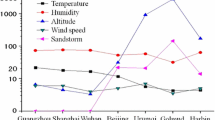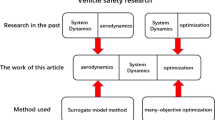Abstract
As a complex mechatronic system, the running stability, safety, and comfort of high-speed train are affected by many design variables. It is of great difficulty to identify a set of effective design parameters to optimize its running performance. The current simulation systems like the SIMPACK can simulate the running dynamics, but cannot be used effectively for optimal design of the train and rail system because there are too many design variables being supposed to be dealt with. Therefore, there is a need to make a software solution from simulation analysis to optimal design so that the computer-aided design (CAD) and engineering (CAE) can be integrated into an integral design process. This paper presents a new method to identify the key design variables against the running performance indicators based on the sensitivity analysis, which in turn bases itself on simulation-oriented surrogate models. In this way, the optimal design of a high-speed train can be successfully conducted because (1) the surrogate model can reduce the simulation time greatly and (2) the design variable space with the key variables will be reduced significantly. The research shows that this method is of practical significance for speeding up the design of high-speed train or similar complex mechatronic systems.
Similar content being viewed by others
References
Wang GG, Shan S (2007) Review of meta-modeling techniques in support of engineering design optimization. ASME Trans ASME 129(4):370–380
Forrester AI, Keane AJ (2009) Recent advances in surrogate-based optimization. Prog Aerosp Sci 45:50–79
Simpson TW, Peplinski JD, Koch PN, Allen JK (2001) Meta-models for computer-based engineering design: survey and recommendations. Eng Comput 17:129–150
Golovidov O, Mason WH (1997) Response surface approximations for aerodynamic parameters in high speed civil transport optimization. Technical Report
Hosder S, Watson LT, Grossman B, Mason WH, Kim H, Haftka RT, Cox SE (2001) Polynomial response surface approximations for the multidisciplinary design optimization of high speed civil transport. Optim Eng 2(4):431–452
Unal R, Lepseh RA, Mcmillin M (1998) Response surface model building and multi-disciplinary optimization using D-optimal designs, Collection of Technical Papers for 7th Annual AIAA/NASA/ISSMO Symposium on Multidisciplinary Analysis and Optimization 18:405–411
Knill DL, Giunta AA, Baker CA, Grossman B, Mason WH, Haftka RT, Watson LT (1999) Response surface models combining linear and Euler aerodynamics for supersonic transport design aircraft 36(1):75–86
Balabanov VO, Giunta AA, Golovidov O, Grossman B, Mason WH, Watson LT, Haftka RT (1999) Reasonable design space approach to response surface approximation. J Aircr 36(1):308–315
Yan Z et al (2003) Application of neural network in the study of combustion rate of natural gas/diesel dual fuel engine. Chin J Zhejiang Univ Sci 4(2):170–174
Yi YK, Malkawi AM (2011) Integrating neural network models with computational fluid dynamics (CFD) for site-specific wind condition. Build Simul 4:245–254
Jiang Z (2009) Optimization of high-pressure die-casting process parameters using artificial neural network. Int J Adv Manuf Technol 44:667–674
Mu XF, Tao WX (2005) Researches of common surrogate model in the multidisciplinary optimization design. Chin J Comput Mech 22(5):608–612
Wang HZ (2010) Dynamic multi-object vibration reduction optimization of a helicopter rotor based on modal shaping, Doctoral thesis, Nanjing University of Aeronautics and Astronautics
Gorissen D (2010) Grid-enabled Adaptive Surrogate Modeling for Computer Aided Engineering. Phd. Thesis, Ghent University, March
Gorissen D, Couckuyt I, Demeester P, Dhaene T (2011) A surrogate modeling and adaptive sampling toolbox for computer based design. J Mach Learn Res 11:2051–2055
Hedayat A, Sloane N, Stufken J (1999) Orthogonal arrays: theory and applications. Springer, Berlin
Morris MD, Mitchell TJ (1995) Exploratory designs for computational experiments. J Stat Plan Infer 43(3):381–402
Lee TH, Jung JJ (2007) A sampling technique enhancing accuracy and efficiency of meta-model-based RBDO: constraint boundary sampling. Comput Struct 6:1–14
Lin Y (2004) An efficient robust concept exploration method and sequential exploratory experimental design, Doctoral thesis, Mechanical Engineering, Georgia Institute of Technology, Atlanta, GA
Jin R, Chen W, Sudjianto A (2005) An efficient algorithm for constructing optimal design of computer experiments. J Stat Plan Infer 134(1):268–287
McKay MD, Beckman RJ, Conover WJ (1979) A comparison of three methods for selecting values of input variables in the analysis of output from a computer code. Technometrics (Am Stat Assoc) 21(2):239–245
Iman RL, Helton JC, Campbell JE (1981) An approach to sensitivity analysis of computer models, Part 1. Introduction, input variable selection and preliminary variable assessment. J Qual Technol 13(3):174–183
Iman RL, Davenport JM, Zeigler DK (1980) Latin hypercube sampling (program user's guide)
Sacks J, Welch WJ, Mitchell TJ, Wynn HP (1989) Design and analysis of computer experiments (with discussion). Stat Sonica 4:409–435
Koehler J, Owen A (1996) Computer experiments, In S. Ghosh and C.R. Rao, editors, Handbook of Statistics, 13: Design and Analysis of Experiments, 261–308. North Holland, New York
Kim J, Park K, Yoon S, Choi D, Park Y, Lee J, Park N (2005) Design and optimization of suspension with optical flying head using integrated optimization frame. J Soc Inf Storage Syst 1(2):161–168
Jongsoo L, Jeong H, Kang S (2008) Derivative and GA-based methods in metamodeling of back-propagation neural networks for constrained approximate optimization. Struct Multidiscip Optim 35(1):29–40
Tchaban T, Taylor MJ, Griffin A (1998) Establishing impacts of the inputs in a feedforward neural network. J Neural Comput Appl 7(4):309–317
Ding YC et al (2008) Welded structure fatigue optimization design based on the Kriging model. Chin J Dalian Jiaotong Univ (2):7–11
Cheng YC, Lee CK (2010) Integration of uniform design and Kriging interpolation to the optimization of suspension parameters of a high speed railway vehicle, Proceedings of the 2010 International Conference on Modeling, Identification and Control, Okayama, Japan, July 17–19
Kim Y, Park CY, et al (2003) Design optimization for suspension system of high speed Train using neural network, JSME Int J Series C 46(2):388–393
Park CY, Kim Y, Bae D (2009) Sensitivity analysis of suspension characteristics for Korean high speed train. J Mech Sci Technol 23:938–941
He Y (2011) Design oriented dynamics modeling and sensitivity analysis of railway vehicles, doctoral dissertation, Southwest Jiaotong University
Dong J (2004) Design sensitivity analysis and optimization of high frequency structural-acoustic problems using energy finite element method and energy boundary element method [D]. PhD Thesis, The University of Iowa
Anderson KS, Hsu YH (2002) Analytical full-recursive sensitivity analysis for multibody chain systems. J Multibody Syst Dyn 8(1):1–27
Hsu YH, Anderson KS (2002) Recursive sensitivity analysis for constrainted multi-rigid-body dynamic systems design optimization. J Struct Multidiscip Optim 24(4):312–324
German HC (2006) Computer-aided design sensitivity analysis for dynamic multibody systems [D]. PhD Thesis, The University of Iowa
Chi MR, et al (2007) The analysis of bogie suspension parameters of high speed passenger car. Chin J Dalian Jiaotong Univ (9)
Yildiz AR (2013) Comparison of evolutionary based optimization algorithms for structural design optimization. Eng Appl Artif Intell 26(1):327–333
Yildiz AR (2013) A new hybrid bee colony optimization approach for robust optimal design and manufacturing. Appl Soft Comput 13(5):2906–2912
Yildiz AR (2009) A novel particle swarm optimization approach for product design and manufacturing. Int J Adv Manuf Technol 40(5–6):617–628
Yildiz AR (2012) A new hybrid particle swarm optimization approach for structural design optimization in automotive industry. J Automob Eng 226(D10):1340–1351
Yildiz AR, Solanki KN (2012) Multi-objective optimization of vehicle crashworthiness using a new particle swarm based approach. Int J Adv Manuf Technol 59(1–4):367–376
Yildiz AR, Saitou K (2011) Topology synthesis of multicomponent structural assemblies in continuum domains. ASME J Mech Des 133:1
Yildiz AR (2009) A new design optimization framework based on immune algorithm and Taguchi method. Comput Ind 60(8):613–620
Yildiz AR, Durgun I (2012) Structural design optimization of vehicle components using Cuckoo search algorithm. Mater Test 54(3):185–188
Author information
Authors and Affiliations
Corresponding author
Rights and permissions
About this article
Cite this article
Zhang, J., Ding, G.F., Zhou, Y.S. et al. Identification of key design parameters of high-speed train for optimal design. Int J Adv Manuf Technol 73, 251–265 (2014). https://doi.org/10.1007/s00170-014-5822-7
Received:
Accepted:
Published:
Issue Date:
DOI: https://doi.org/10.1007/s00170-014-5822-7




